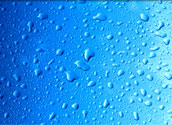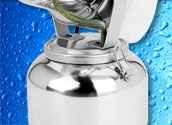 |
 |
 |
 |
 |
 |
 |
 |
1. What products can be used in a Fogmaster fogger?
What products can be used in a Fogmaster fogger? Fogmaster foggers are capable of atomizing light liquids -- both water- and oil-based -- including pesticides, deodorants, disinfectants and, of course, water. Heavier liquids can also be fogged, providing their viscosity and surface tension is not too great. (Viscosity and surface tension affect both output rate and droplet size distribution.) However, do not fog a flammable liquid due to the risk of fire or explosion. Standard Fogmaster products use an open frame motor, which is not explosion-proof. (If an explosion proof motor is required for a fogging application, contact the factory to discuss a custom unit for the application.)
What other safety factors should I consider? First, read the chemical label to make certain that fogging is appropriate for your chemical. Most chemical labels, and all pesticide labels, have instructions for use, application rates, and sometimes even the application equipment to be used. If the chemical label has application instructions, follow them. If the label does not have application instructions, use caution and common sense, remembering that some chemicals may cause injury, or even death, if used inappropriately. Remember also that the small droplets of a fog can travel a great distance before settling or dissipating. Be sure to consider the safety of animals, objects or other people that may be in, or downwind of, the application area. In summary, know what you are applying. Never fog an unknown chemical.
What protective equipment should I wear when fogging? That depends on the circumstances of your application, the potential routes of exposure (including inhalation, skin absorption, and dissolution in saliva or nasal or eye fluids) and the properties of the chemical you are using. A material safety data sheet (MSDS) is often enclosed with chemical products. Prepared by the chemical manufacturer, the MSDS contains safety and technical information about the product (including corrosiveness, flammability, toxicity, reactivity, first aid, etc.). Your salesperson or a representative of the chemical manufacturer can help you interpret the MSDS. You can also write Fogmaster for application and safety information. Send a letter, fax or e-mail -- no telephone advice is given -- describing the application and chemical you propose to use. Enclose a copy of the chemical label or instructions for use, and a copy of the MSDS if you have one. We will try to be helpful, within the limits of our knowledge. However, we do not manufacture or sell chemicals, and we are not familiar with all chemical products. The Fogmaster Corporation cannot regulate the use to which you may put the equipment it manufactures and assumes no liability for any direct, indirect or consequential damage which may arise out of such use.
What is the particle size of your fog? In general, the output of Fogmaster foggers falls in a range from a near-invisible ULV dry fog (7-10 micron diameter), to an intermediate fog (15-20 microns), to a heavy, wet fog (30+ microns). Droplet size differs with nozzle design, fogger model number, liquid discharge rate and, of course, the liquid being applied. For a given model, a lower liquid rate yields smaller particles; at equal rates, liquids with lower surface tension and viscosity yield smaller particles. In general, an oil-based fogging solution yields smaller particles than an aqueous one. Many Fogmaster foggers provide control of liquid rate and particle size. See the specifications page of each model for data on its droplet size range.
How do I measure fogger output rate? We include calibration procedures with each unit. These vary slightly for different models, but here's a general approach:
Remember, first adjust the fogger for the desired particle size, then measure the liquid flow rate which produces that size output in your setting. Do not calibrate a fogger with a dangerous chemical (or an expensive one). Instead, make an approximate calibration, using water (as a substitute for a water-based product) or light kerosene (for an oil-based one). After you put the fogger into service, use actual data on liquid consumption and fogging times to refine your calibration.
How large an area can I treat? Fogmaster foggers can treat a large area very quickly; 4-5,000 cubic feet per minute is fairly typical for a ULV (ultra low volume) application at a conventional dosage rate (1-2 oz/MCF).
How much chemical should I apply (or how long should I fog)? For a space treatment, see the chemical label. It will usually specify an application rate (for example, ounces per 1000 cubic feet of space treated). After you have adjusted the fogger particle size and measured its output rate, determine the fogging time as follows:
For a surface treatment, follow a similar procedure but use the surface area of the treatment area rather than room volume. Some chemical labels give qualitative application rates -- for example, spray until damp, or spray until run-off occurs; follow those instructions. When making surface applications, treat uniformly to cover all surfaces evenly. Lastly, such "open air" applications as odor control at a landfill or sewage treatment plant involve repeat discharge under the control of a timer or gas monitor. The effects of temperature, odor intensity, wind direction, chemical efficacy, etc. cannot be predicted, so you will have to experiment to determine optimum chemical dilution rates and cycle times.
What chemical does Fogmaster recommend or sell? The Fogmaster Corporation does not sell or recommend specific chemicals. However, many of our distributors sell or manufacture chemicals, and we can refer you to them for assistance.
How would you fog a warehouse for pests? First select your chemical and read its instructions for use. Pay close attention to safety issues. For example, the label may warn you to keep other people out of the treatment area during or after application, or require you to wear a respirator during application. Second, decide when and how you will make the application, consistent with these instructions. A turntable and timer can help when you must fog a warehouse with a hand-held unit. The fogger is placed on the turntable and controlled by a timer. You can use a long extension cord to turn it on from another room, or a timer. Put enough chemical in the fogger to do the job. Place the fogger and turntable in an unobstructed place, set the timer and depart.
Generally, Fogmaster products require little maintenance. Keep your fogger and air filter clean. After using, drain and rinse tank and run fogger head a minute or two to clear remaining liquid from internal lines. See maintenance for other tips.
Some distributors provide repair services. Also, Fogmaster provides repair services (for Fogmaster products only) at our factory. We charge for parts only (no labor charge).
We do warranty repairs at our factory (shipping instructions).
I do my own service. Where can I buy parts? Many distributors keep some parts on hand, or you can purchase parts from Fogmaster. A numbered parts drawing is enclosed with each product shipped. The product page of many products includes a link where you can download a PDF copy of the parts list and drawing. Also, we can fax or Email you a copy. For additional help, please see our Trouble Shooting Guide to help you diagnose and repair the most common fogger issues.
|
| Home | About Us | Products | Applications | FAQ | Support | Contact Us |